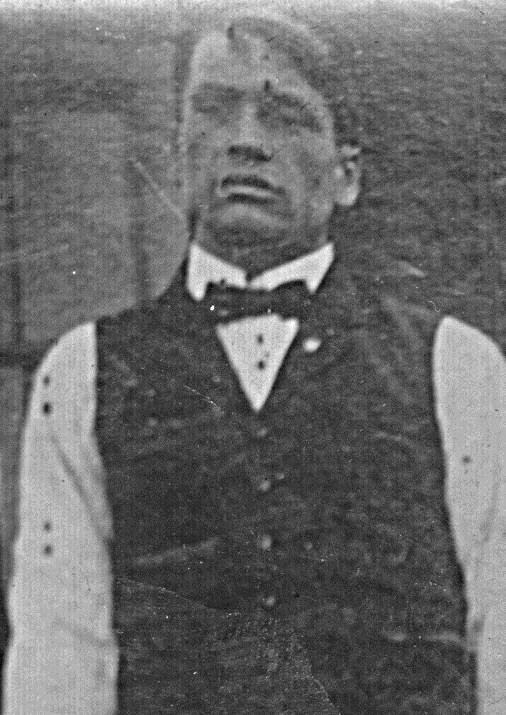Home > Family History > LaPatka > Uncle Mike LaPatka
 |
Mike LaPatka |
|
|
More Photos Mike's Death Certificate Gravesite Photos |
||
|
Michael “Mike” LoPatka was born in November 1882, in the Hungarian portion of the dual-monarchy of Austria-Hungary. Records are conflicting, but he was probably born on November 10 or 15, 1882. However, other records show his date of birth as Oct 19, 1882, while his death certificate provides it as July 18, 1881. Mike was the son of Michal LoPatka and Maria (Bobkova) LoPatka and had an older brother named Jan “John” LoPatka, born June 30, 1873, and possibly a sister named Anna. The name “Anna” is sometimes associated as being the name of his stepmother as well. He was raised in the village of Olsavica, along the River Torysky in the high hills near the foot of the Carpathian Mountains. The area is now in the Levoca District of the Presov Region of the modern-day Slovak Republic (also known as Slovakia), just west of the city of Presov and near the border of Poland. The region has seen a lot of change politically. The Kingdom of Hungary, founded 1000, became part of the Austro-Hungarian Empire in 1867. In October 1918, at the end of the Great War (World War I), the Austro-Hungarian Empire was dissolved and the area where Mike was born became part of Czechoslovakia. In January 1993, Czechoslovakia peacefully split into the Czech Republic and the Slovak Republic. In the late 1880’s, mostly due to rampant poverty but also other factors, many peasants from Central Europe, including from Austria-Hungary, began migrating abroad seeking better economic opportunity. Those from Austria-Hungary usually made their way via horse-drawn wagons northwest to the ports of Bremen or Hamburg in northern Germany. From there they would travel via steamship, usually via a brief stop in England, for the two-three week voyage to the United States or Canada. Mike’s older brother John was among those who emigrated aboard in approximately 1892-1894. Mike would have been aged twelve-fourteen during this time. I believe his father Michal and sister Anna traveled with John as they made their way to Johnstown in western Pennsylvania. It’s possible they left in response to the death of Michal’s wife (and Mike’s mother). I know Mike remained in Olsavica, but who he lived with is unknown. It’s believed father Michal passed away in Pennsylvania, but when and where this happened is unknown. It is known the LoPatka’s were initially in Johnstown, and John (possibly by himself) made his way to nearby Charleroi and then to the southside of Pittsburgh by the turn of the century. John met a girl in Pittsburgh named Mary Brinczkova, who oddly enough she was from a town only a few miles away from John’s home back in the Old Country. They acquired a marriage application in early 1901, (but apparently never married) and the first of their many children, a child named George, was born a few months later in May. Soon after this they moved up north and settled in the village of Chewton in Lawrence County, Pennsylvania, where Mary’s half-brother Mike Burik was living. John must have called for his brother to join him at some point. In June 1906, when he was age twenty-four, Mike made his way to Bremen in Germany to secure passage to America. From there he would have traveled a bit north to the port of Bremerhaven to board the steamship Rhein of the Norddeutscher Lloyd line. The Rhein departed on Thursday, June 7, 1906, for the approximately two-week journey. The ship’s manifest indicates he was in possession of $50. At Baltimore, unlike other American immigration points, the custom agents would board the vessels near the mouth of the Chesapeake Bay and screen the passengers as they steamed towards the port. This was an efficient system and if cleared en route by custom officials Mike and other passengers would have been free to depart the dock as soon as they arrived. The vessel pulled into the Baltimore & Ohio Railroad (B&O) piers at Locust Grove, near Fort McHenry and across from the Fell’s Point immigration area, on June 22. From there Mike probably boarded a B&O train and traveled all the way up to the Chewton area. The ship Mike traveled on had an interesting future. In August 1914, when war broke out in Europe, the neutral U.S. government interned the Rhein, docked in Baltimore at that time, and other German ships in American ports. The Rhein sat idle in Baltimore for the next three years. When the U.S. government declared war on Germany in April 1917 the vessel was seized as a prize of war. The ship received a major overhaul and was pressed into naval service as the USS Susquehanna in September 1917. After the war she briefly served as a passenger liner before being retired in late 1922. She was sold to a Japanese company in 1928 and subsequently scrapped. By most accounts Mike, called Uncle Mike by the LoPatka kids, was a bit of a strange man. He has been referred to as mentally “slow,” but he was always very nice and would often bring the kids candy. He may have initially lived with John and Mary and their three children in their house on Plum Way, but over the years he resided at various locations including with the Burik family in Chewton. Beginning in 1914 the monumental “Great War” (later known as World War I) was raging across Europe, but the isolationist-minded United States managed to remain officially neutral for the time being. Before long the Reverend Frances A. Maloney, the pastor of St. Monica’s Catholic Church in nearby Wampum, apparently convinced John LoPatka to change the spelling of the family surname to the more Americanized form of “LaPatka.” This was probably suggested as a way to distance the family from their native Austro-Hungarian homeland, which was aligned with Imperial Germany during the Great War. All the family members eventually accepted this change except for son Frank, who kept the LoPatka name for the rest of his life. Sometime during the timeframe 1913-1917 John rented out his house in Chewton and moved the whole family by train to Cleveland, Ohio, to find better work. I do not believe Mike went with them, but either way the LaPatka family returned to Chewton after only three months. Later, in June 1917, the family purchased a 16-acre farm and moved to the northern outskirts of northern Chewton. In April 1917, prodded on by the threat of German U-boat (submarine) attacks off the Eastern Seaboard, the U.S. government was drawn in and declared war on Germany. Later that year, on December 7, the federal government also declared war on Mike’s home country of Austria-Hungary. In September 1918, when he was thirty-three years old, Mike had to register for the military draft. Mike took part in the third and final draft registration (held on September 12, 1918) and included all men up to age forty-six. Mike was never called into service as hostilities in Europe came to a close in November 1918. His draft card reveals he was employed as a laborer with the Lawrence Limestone Company, probably employed in the extensive limestone mines located just north of Clinton Cemetery in Wampum. The 1920 U.S. Census reveals Mike, employed as a laborer on the railroad, is living in Chewton with Mike and Anna Burik and their ten children. By 1930 he was renting a small house or apartment on Water Street in Wampum and employed as a “track walker” with the Pennsylvania & Lake Erie Railroad Company (P&LE). (NOTE: The P&LE tracks are the ones in Wampum running alongside the Beaver River, stretching from Pittsburgh up to Youngstown, Ohio.) A track walker was essentially an inspector who walked an assigned section of the track on a daily basis (sometimes even at night with a lantern) examining the rails, joints, and ties. Sometime during the late 1930’s and 1940’s, Mike was also employed as a doorman at the Slovak Club located near the ball field in Chewton. The Slovak Club, a members-only establishment affiliated with the National Slovak Society (NSS), was managed by Mike’s nephew Joe LaPatka. Several other men in the family worked at the club, which had a bar in the basement known for its notorious happenings. Mike even lived at the club for a while. Mike’s 1942 World War II draft registration card (he was age fifty-nine) lists his employer as the P&LE and his emergency contact as “Joe Burick.” Joe was one of Mike Burik’s sons. Mike soon took up residence on the LaPatka farm out on Tony Dytko Road. It is known that Joe LaPatka brought him out there, but when this exactly happened is unknown. It seems a good possibility it happened upon his retirement in the mid 1940’s (he would have been age sixty-two in late 1945). He took up residence in a small out building (a converted shed) on a hill near the back of the main house. The shed was fixed up with a bed and a stove and had previously been used by his sister-in-law Mary LaPatka to cook dinners during the summer months. Mike continued to live on the LaPatka farm, as his nephew Frank LoPatka (he kept the traditional surname spelling) took ownership of the property and remained in the main house. Mike grew ill and in November 1953 he learned he was suffering from stomach cancer. He died not long after on January 27, 1954, at the age of seventy-two. Marshall Funeral Home in Wampum handled the funeral arrangements and I do not believe there was any public viewing or service. Mike was not interred in any of the six vacant LaPatka plots at St. Nicholas Cemetery. There was apparently a family dispute about him being buried in the LaPatka lot, and a separate plot was purchased for him nearby at the same cemetery. Joe LaPatka Sr., who looked out for Uncle Mike over the years, signed the death certificate and probably oversaw all the final arrangements for Mike’s burial.
|










